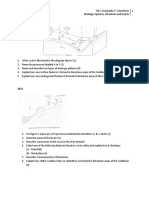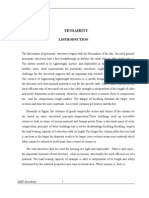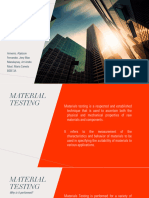Tensegrity: Learning Resource
Uploaded by
Trevor G. SamarooTensegrity: Learning Resource
Uploaded by
Trevor G. SamarooLEARNING RESOURCE
Tensegrity
INTRODUCTION
Tensegrity is a term coined by Buckminster Fuller to describe the You’ll see tension helping to lightweight a bicycle wheel in two
strategy of using tension for structural integrity. Sometimes ways. The spokes that connect the hub and the rim are in tension,
turning compressive stress into tensile stress can help you and can be much thinner and lighter than if they were in
reduce material use. It’s ideal when working with materials that compression. The inflated rubber tire is also in tension and
have strength in tension, which is similar to their strength in maintains its shape due to its internal air pressure.
compression.
STRENGTH IN TENSION
Any design that resists compression forces is also resisting
buckling. Compression can buckle your product long before the
strength of the materials fail, especially in long or skinny parts.
By contrast, a part under tension will fail at the yield strength of
the material. So you can make the elements in tension thinner
without compromising structural integrity.
| academy.autodesk.com LIGHTWEIGHTING: TENSEGRITY
p. 1
You might also like
- Csec Past Papers With Solutions: Informationtechnology Paper 1 2 0 1 2 - 2 0 1 80% (6)Csec Past Papers With Solutions: Informationtechnology Paper 1 2 0 1 2 - 2 0 1 81 page
- The Engineering Guide To LightweightingNo ratings yetThe Engineering Guide To Lightweighting18 pages
- Tensegrity and Spine. A New Biomechanical Model by Jean Claude de Mauroy, Jean François Salmochi100% (3)Tensegrity and Spine. A New Biomechanical Model by Jean Claude de Mauroy, Jean François Salmochi4 pages
- A Biotensegrity Explanation For Structural Dysfunction in The Human Torso100% (2)A Biotensegrity Explanation For Structural Dysfunction in The Human Torso21 pages
- The New Structural Concept Tensairity: Basic Principles: R.H. Luchsinger A. Pedretti, M. Pedretti & P. SteingruberNo ratings yetThe New Structural Concept Tensairity: Basic Principles: R.H. Luchsinger A. Pedretti, M. Pedretti & P. Steingruber5 pages
- Fabrication and Analysis of Tensegrity Based Prism StructureNo ratings yetFabrication and Analysis of Tensegrity Based Prism Structure5 pages
- An Introduction To The Mechanics of Tensegrity StructuresNo ratings yetAn Introduction To The Mechanics of Tensegrity Structures6 pages
- Building Tensegrity Models: How High Can You Go?No ratings yetBuilding Tensegrity Models: How High Can You Go?7 pages
- Building Tensegrity Models Make V6-140814094334-Phpapp02 PDF100% (1)Building Tensegrity Models Make V6-140814094334-Phpapp02 PDF7 pages
- Mechanical Properties of Material 1731244266No ratings yetMechanical Properties of Material 17312442667 pages
- Properties and How They Can Be Altered: VC, N:VNo ratings yetProperties and How They Can Be Altered: VC, N:V13 pages
- GROUP 8 - Material Testing Written Report (MEC 0325-1)No ratings yetGROUP 8 - Material Testing Written Report (MEC 0325-1)22 pages
- Exploring Tensile Testing A Comprehensive GuideNo ratings yetExploring Tensile Testing A Comprehensive Guide8 pages
- Mass Reduction Methods For Energy Efficiency Improvement of VehiclesNo ratings yetMass Reduction Methods For Energy Efficiency Improvement of Vehicles10 pages
- Intro To Mechanics of Tensegrity StructuresNo ratings yetIntro To Mechanics of Tensegrity Structures6 pages
- Adhesives Retain With Confidence Tech ArticleNo ratings yetAdhesives Retain With Confidence Tech Article4 pages
- Outline: Review of Mechanical Properties of MaterialsNo ratings yetOutline: Review of Mechanical Properties of Materials6 pages
- Strength Vs Stiffness Vs Hardness - How Are They Different in ManufacturingNo ratings yetStrength Vs Stiffness Vs Hardness - How Are They Different in Manufacturing10 pages
- (385 463) The Racing Motorcycle Volume 2 John BradleyNo ratings yet(385 463) The Racing Motorcycle Volume 2 John Bradley79 pages
- Welding Metallurgy, Part 1: Understanding Mechanical PropertiesNo ratings yetWelding Metallurgy, Part 1: Understanding Mechanical Properties4 pages
- Destructive Testing EMM Presentation (Group 1)No ratings yetDestructive Testing EMM Presentation (Group 1)28 pages
- Overview of Tensegrity - I: Basic Structures: Engineering MECHANICS, Vol. 21, 2014, No. 5, P. 355-367No ratings yetOverview of Tensegrity - I: Basic Structures: Engineering MECHANICS, Vol. 21, 2014, No. 5, P. 355-36713 pages
- Elements of Solid Mechanics By: MD - Mohit-Ul AlamNo ratings yetElements of Solid Mechanics By: MD - Mohit-Ul Alam43 pages
- Disassembly & Recycling: Learning ResourceNo ratings yetDisassembly & Recycling: Learning Resource1 page
- Canadian School of Arts and Science Easter Term Exam - March 2020 Physics - Paper 2 (Total 100 Marks) Grade 11 2 Hours 30 MinutesNo ratings yetCanadian School of Arts and Science Easter Term Exam - March 2020 Physics - Paper 2 (Total 100 Marks) Grade 11 2 Hours 30 Minutes18 pages
- Reinforcing Strategies: Learning ResourceNo ratings yetReinforcing Strategies: Learning Resource1 page
- Csec Past Papers With Solutions: Principles of Business Paper 1 2 0 0 2 - 2 0 0 80% (2)Csec Past Papers With Solutions: Principles of Business Paper 1 2 0 0 2 - 2 0 0 81 page
- Canadian School of Arts and Science Easter Term Exam - March 2020 Mathematics - Paper 2 (Total 100 Marks) Grade 11 2 Hours 30 MinutesNo ratings yetCanadian School of Arts and Science Easter Term Exam - March 2020 Mathematics - Paper 2 (Total 100 Marks) Grade 11 2 Hours 30 Minutes20 pages
- Data Response: Population, Economy and Settlement 2013No ratings yetData Response: Population, Economy and Settlement 20133 pages
- Physics: Completed Completed Completed CompletedNo ratings yetPhysics: Completed Completed Completed Completed3 pages























































































